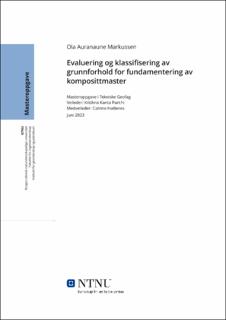| dc.contributor.advisor | Panthi, Krishna Kanta | |
| dc.contributor.advisor | Hatlenes, Catrine | |
| dc.contributor.author | Markussen, Ola Auranaune | |
| dc.date.accessioned | 2023-09-30T17:22:07Z | |
| dc.date.available | 2023-09-30T17:22:07Z | |
| dc.date.issued | 2023 | |
| dc.identifier | no.ntnu:inspera:147161988:35200602 | |
| dc.identifier.uri | https://hdl.handle.net/11250/3093333 | |
| dc.description.abstract | Strømnettet er en viktig del av infrastrukturen i Norge, og pålitelig strømforsyning er avgjørende for et moderne samfunn. I næringslivet, offentlig tjenesteyting og i husholdninger regnes tilgang på strøm som en selvfølge. Basert på andre undersøkelser består strømnettet i Norge i dag av omlag to millioner tremaster, hvorav de kreosotimpregnerte mastene har en estimert levetid på omtrent 70 år. Overgangen fra tremaster til komposittmaster gir flere miljømessige fordeler gjennom mer bærekraftige master, lengre levetid, og redusert påvirkning på naturen rundt mastepunktene.
I Norge tilbyr Comrod AS levering og installasjon av komposittmaster, og har utviklet sin egen fundamenteringsmetode for mastene. Metoden utnytter berggrunnens styrke ved å bore en slisse i bergmassen hvor et rørfundament installeres og gyses fast for stabilisering. Denne metoden krever hverken sprenging eller støping av fundament, noe som begrenser fotavtrykket rundt mastene til diameteren av selve masten. I tillegg reduserer metoden behovet for anleggsveier inn til mastepunktene ved å transportere borerigg og master via luftveien for fundamentering og montering. Slisseboringen gjør det mulig å installere master i brattere terreng, samt øke avstanden mellom mastepunktene på grunn av fundamentets styrke. Dette gir større fleksibilitet for å velge optimal linjetrasé og plassering av mastepunkt.
Denne oppgaven fokuserer på videre utvikling av fundamenteringsmetoden med et mål om å etablere standardiserte prosedyrer for de ulike fasene av prosjektene. I denne masteroppgaven er det gjennomført analyser av diverse empiriske bergmasseklassifiseringer, for å danne et utgangspunkt for et standard klassifiseringssystem til bruk under forundersøkelsene før slissefundamenteringen. Et videreutviklet klassifiseringssystem for å vurdere bergmassens egnethet for slissefundamentering og tilhørende fundamenteringsdybde er sammenfattet i denne oppgaven. I tillegg er det gjennomført analyser av fundamenteringmetodens styrke ved å undersøke tidligere prosjekter, tester, og ved bruk av numeriske modeller i Abaqus. Resultatene viser hvordan dimensjonene på rørfundamentet påvirker deformasjonen og kapasiteten til bergmassen. Funnene viser at fundamentets diameter påvirker bergmassen i større grad enn fundamenteringsdybden. Under slisseboringen er det enklere å øke fundamenteringsdybden enn diameteren, noe som understreker viktigheten av grundige vurderinger av bergmassene i tidlig fase av prosjekteringen. | |
| dc.description.abstract | The power grid is an essential part of the infrastructure in Norway, where reliable electricity supply is crucial for a modern society and is considered a necessity in business, public services, and households. Former research indicates that there are approximately two million wooden utility poles present in Norway, with creosote-treated poles having an estimated lifespan of about 70 years. The transition from wooden poles to composite poles offers several environmental benefits, including increased sustainability, longer lifespan, and reduced impact on the surrounding environment of the masts.
In Norway, Comrod AS provides delivery and installation of composite utility poles and has developed their own foundation method for these poles. The method utilizes the strength of the bedrock. A slot is drilled in the rock mass and composite utility poles are installed into the foundation slot and grouted for stabilization. This method does not require blasting or concrete casting, limiting the footprint around the poles to the diameter of the pole itself. The method also reduces environmental impact by eliminating the need for access roads to the pole locations, as drilling rigs and poles are transported by air. The slot drilling enables the installation of poles in steeper terrain and allows for increased distances between pole locations due to the strength of the foundation. This provides greater flexibility in the selection of optimal transmission alignment and position placement.
This thesis focuses to further develop the foundation method with an aim to establish a standardized procedures for the different phases of the projects. Analyses of various empirical rock mass classifications have been conducted to form a basis for a standardized classification method to be used during the preliminary investigations for the slot foundation. A classification procedure to assess the suitability of slot foundation and to recommend foundation depth based on the quality of the rock mass has also been made. In addition, the strength of the foundation method has been analyzed through the examination of previous projects, tests, and numerical modeling using Abaqus. The results demonstrate how the dimensions of the pipe foundation influence the deformation and capacity of the rock mass. Findings indicate that the diameter of the foundation has a greater impact on the rock mass compared to the foundation depth. During slot drilling, it is easier to increase the foundation depth than the diameter, emphasizing the importance of thorough assessments of the rock mass in the early stages of the project. | |
| dc.language | nob | |
| dc.publisher | NTNU | |
| dc.title | Evaluering og klassifisering av grunnforhold for fundamentering av komposittmaster | |
| dc.type | Master thesis | |
